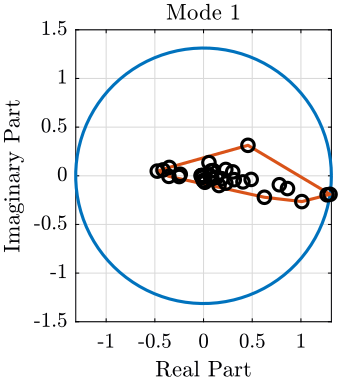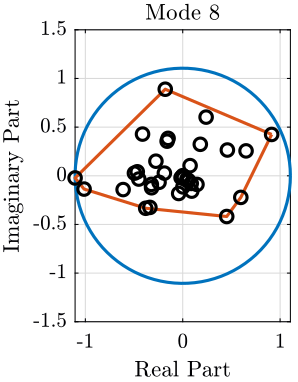18 KiB
Modal Analysis
- Setup
- Mode extraction and importation
- Positions of the sensors
- Solids
- From local coordinates to global coordinates
- Modal Matrices
- Modal Complexity
- Some notes about constraining the number of degrees of freedom
- Normalization of mode shapes?
- Compare Mode Shapes
- Synthesis of FRF curves
Mode extraction and importation
First, we split the big modes.asc files into sub text files using bash.
sed '/^\s*[0-9]*[XYZ][+-]:/!d' modal_analysis_updated/modes.asc > mat/mode_shapes.txt
sed '/freq/!d' modal_analysis_updated/modes.asc | sed 's/.* = \(.*\)Hz/\1/' > mat/mode_freqs.txt
sed '/damp/!d' modal_analysis_updated/modes.asc | sed 's/.* = \(.*\)\%/\1/' > mat/mode_damps.txt
sed '/modal A/!d' modal_analysis_updated/modes.asc | sed 's/.* =\s\+\([-0-9.e]\++[0-9]\+\)\([-+0-9.e]\+\)i/\1 \2/' > mat/mode_modal_a.txt
sed '/modal B/!d' modal_analysis_updated/modes.asc | sed 's/.* =\s\+\([-0-9.e]\++[0-9]\+\)\([-+0-9.e]\+\)i/\1 \2/' > mat/mode_modal_b.txtThen we import them on Matlab.
shapes = readtable('mat/mode_shapes.txt', 'ReadVariableNames', false); % [Sign / Real / Imag]
freqs = table2array(readtable('mat/mode_freqs.txt', 'ReadVariableNames', false)); % in [Hz]
damps = table2array(readtable('mat/mode_damps.txt', 'ReadVariableNames', false)); % in [%]
modal_a = table2array(readtable('mat/mode_modal_a.txt', 'ReadVariableNames', false)); % [Real / Imag]
modal_a = complex(modal_a(:, 1), modal_a(:, 2));
modal_b = table2array(readtable('mat/mode_modal_b.txt', 'ReadVariableNames', false)); % [Real / Imag]
modal_b = complex(modal_b(:, 1), modal_b(:, 2));We guess the number of modes identified from the length of the imported data.
acc_n = 23; % Number of accelerometers
dir_n = 3; % Number of directions
dirs = 'XYZ';
mod_n = size(shapes,1)/acc_n/dir_n; % Number of modesAs the mode shapes are split into 3 parts (direction plus sign, real part and imaginary part), we aggregate them into one array of complex numbers.
T_sign = table2array(shapes(:, 1));
T_real = table2array(shapes(:, 2));
T_imag = table2array(shapes(:, 3));
modes = zeros(mod_n, acc_n, dir_n);
for mod_i = 1:mod_n
for acc_i = 1:acc_n
% Get the correct section of the signs
T = T_sign(acc_n*dir_n*(mod_i-1)+1:acc_n*dir_n*mod_i);
for dir_i = 1:dir_n
% Get the line corresponding to the sensor
i = find(contains(T, sprintf('%i%s',acc_i, dirs(dir_i))), 1, 'first')+acc_n*dir_n*(mod_i-1);
modes(mod_i, acc_i, dir_i) = str2num([T_sign{i}(end-1), '1'])*complex(T_real(i),T_imag(i));
end
end
endThe obtained mode frequencies and damping are shown below.
data2orgtable([freqs, damps], {}, {'Frequency [Hz]', 'Damping [%]'}, ' %.1f ');| Frequency [Hz] | Damping [%] |
|---|---|
| 11.4 | 8.7 |
| 18.5 | 11.8 |
| 37.6 | 6.4 |
| 39.4 | 3.6 |
| 54.0 | 0.2 |
| 56.1 | 2.8 |
| 69.7 | 4.6 |
| 71.6 | 0.6 |
| 72.4 | 1.6 |
| 84.9 | 3.6 |
| 90.6 | 0.3 |
| 91.0 | 2.9 |
| 95.8 | 3.3 |
| 105.4 | 3.3 |
| 106.8 | 1.9 |
| 112.6 | 3.0 |
| 116.8 | 2.7 |
| 124.1 | 0.6 |
| 145.4 | 1.6 |
| 150.1 | 2.2 |
| 164.7 | 1.4 |
Positions of the sensors
We process the file exported from the modal software containing the positions of the sensors using bash.
cat modal_analysis_updated/id31_nanostation_modified.cfg | grep NODES -A 23 | sed '/\s\+[0-9]\+/!d' | sed 's/\(.*\)\s\+0\s\+.\+/\1/' > mat/acc_pos.txt
We then import that on matlab, and sort them.
acc_pos = readtable('mat/acc_pos.txt', 'ReadVariableNames', false);
acc_pos = table2array(acc_pos(:, 1:4));
[~, i] = sort(acc_pos(:, 1));
acc_pos = acc_pos(i, 2:4);The positions of the sensors relative to the point of interest are shown below.
data2orgtable(1000*acc_pos, {}, {'x [mm]', 'y [mm]', 'z [mm]'}, ' %.0f ');| x [mm] | y [mm] | z [mm] |
|---|---|---|
| -64 | -64 | -296 |
| -64 | 64 | -296 |
| 64 | 64 | -296 |
| 64 | -64 | -296 |
| -385 | -300 | -417 |
| -420 | 280 | -417 |
| 420 | 280 | -417 |
| 380 | -300 | -417 |
| -475 | -414 | -427 |
| -465 | 407 | -427 |
| 475 | 424 | -427 |
| 475 | -419 | -427 |
| -320 | -446 | -786 |
| -480 | 534 | -786 |
| 450 | 534 | -786 |
| 295 | -481 | -786 |
| -730 | -526 | -951 |
| -735 | 814 | -951 |
| 875 | 799 | -951 |
| 865 | -506 | -951 |
| -155 | -90 | -594 |
| 0 | 180 | -594 |
| 155 | -90 | -594 |
Solids
We consider the following solid bodies:
- Bottom Granite
- Top Granite
- Translation Stage
- Tilt Stage
- Spindle
- Hexapod
We create a structure solids that contains the accelerometer number of each solid bodies (as shown on figure fig:nass-modal-test).
solids = {};
solids.granite_bot = [17, 18, 19, 20];
solids.granite_top = [13, 14, 15, 16];
solids.ty = [9, 10, 11, 12];
solids.ry = [5, 6, 7, 8];
solids.rz = [21, 22, 23];
solids.hexa = [1, 2, 3, 4];
solid_names = fields(solids);From local coordinates to global coordinates
From the figure above, we can write:
\begin{align*} \vec{v}_1 &= \vec{v} + \Omega \vec{p}_1\\ \vec{v}_2 &= \vec{v} + \Omega \vec{p}_2\\ \vec{v}_3 &= \vec{v} + \Omega \vec{p}_3\\ \vec{v}_4 &= \vec{v} + \Omega \vec{p}_4 \end{align*}With
\begin{equation} \Omega = \begin{bmatrix} 0 & -\Omega_z & \Omega_y \\ \Omega_z & 0 & -\Omega_x \\ -\Omega_y & \Omega_x & 0 \end{bmatrix} \end{equation}$\vec{v}$ and $\Omega$ represent to velocity and rotation of the solid expressed in the frame $\{O\}$.
We can rearrange the equations in a matrix form:
\begin{equation} \left[\begin{array}{ccc|ccc} 1 & 0 & 0 & 0 & p_{1z} & -p_{1y} \\ 0 & 1 & 0 & -p_{1z} & 0 & p_{1x} \\ 0 & 0 & 1 & p_{1y} & -p_{1x} & 0 \\ \hline & \vdots & & & \vdots & \\ \hline 1 & 0 & 0 & 0 & p_{4z} & -p_{4y} \\ 0 & 1 & 0 & -p_{4z} & 0 & p_{4x} \\ 0 & 0 & 1 & p_{4y} & -p_{4x} & 0 \end{array}\right] \begin{bmatrix} v_x \\ v_y \\ v_z \\ \hline \Omega_x \\ \Omega_y \\ \Omega_z \end{bmatrix} = \begin{bmatrix} v_{1x} \\ v_{1y} \\ v_{1z} \\\hline \vdots \\\hline v_{4x} \\ v_{4y} \\ v_{4z} \end{bmatrix} \end{equation}and then we obtain the velocity and rotation of the solid in the wanted frame $\{O\}$:
\begin{equation} \begin{bmatrix} v_x \\ v_y \\ v_z \\ \hline \Omega_x \\ \Omega_y \\ \Omega_z \end{bmatrix} = \left[\begin{array}{ccc|ccc} 1 & 0 & 0 & 0 & p_{1z} & -p_{1y} \\ 0 & 1 & 0 & -p_{1z} & 0 & p_{1x} \\ 0 & 0 & 1 & p_{1y} & -p_{1x} & 0 \\ \hline & \vdots & & & \vdots & \\ \hline 1 & 0 & 0 & 0 & p_{4z} & -p_{4y} \\ 0 & 1 & 0 & -p_{4z} & 0 & p_{4x} \\ 0 & 0 & 1 & p_{4y} & -p_{4x} & 0 \end{array}\right]^{-1} \begin{bmatrix} v_{1x} \\ v_{1y} \\ v_{1z} \\\hline \vdots \\\hline v_{4x} \\ v_{4y} \\ v_{4z} \end{bmatrix} \end{equation}This inversion is equivalent to a mean square problem.
mode_shapes_O = zeros(mod_n, length(solid_names), 6);
for mod_i = 1:mod_n
for solid_i = 1:length(solid_names)
solids_i = solids.(solid_names{solid_i});
Y = reshape(squeeze(modes(mod_i, solids_i, :))', [], 1);
A = zeros(3*length(solids_i), 6);
for i = 1:length(solids_i)
A(3*(i-1)+1:3*i, 1:3) = eye(3);
A(3*(i-1)+1:3*i, 4:6) = [0 acc_pos(i, 3) -acc_pos(i, 2) ; -acc_pos(i, 3) 0 acc_pos(i, 1) ; acc_pos(i, 2) -acc_pos(i, 1) 0];
end
mode_shapes_O(mod_i, solid_i, :) = A\Y;
end
endModal Matrices
We want to obtain the two following matrices: \[ \Omega = \begin{bmatrix} \omega_1^2 & & 0 \\ & \ddots & \\ 0 & & \omega_n^2 \end{bmatrix}; \quad \Psi = \begin{bmatrix} & & \\ \{\psi_1\} & \dots & \{\psi_n\} \\ & & \end{bmatrix} \]
- How to add damping to the eigen value matrix?
eigen_value_M = diag(freqs*2*pi);
eigen_vector_M = reshape(mode_shapes_O, [mod_n, 6*length(solid_names)])';\[ \{\psi_1\} = \begin{Bmatrix} \psi_{1_x} & \psi_{2_x} & \dots & \psi_{6_x} & \psi_{1_x} & \dots & \psi_{1\Omega_x} & \dots & \psi_{6\Omega_z} \end{Bmatrix}^T \]
Modal Complexity
A method of displaying modal complexity is by plotting the elements of the eigenvector on an Argand diagram, such as the ones shown in figure fig:modal_complexity_small.
To evaluate the complexity of the modes, we plot a polygon around the extremities of the individual vectors. The obtained area of this polygon is then compared with the area of the circle which is based on the length of the largest vector element. The resulting ratio is used as an indication of the complexity of the mode.
A little complex mode is shown on figure fig:modal_complexity_small whereas an highly complex mode is shown on figure fig:modal_complexity_high. The complexity of all the modes are compared on figure fig:modal_complexities.
mod_i = 1;
i_max = convhull(real(eigen_vector_M(:, mod_i)), imag(eigen_vector_M(:, mod_i)));
radius = max(abs(eigen_vector_M(:, mod_i)));
theta = linspace(0, 2*pi, 100);
figure;
hold on;
plot(radius*cos(theta), radius*sin(theta), '-');
plot(real(eigen_vector_M(i_max, mod_i)), imag(eigen_vector_M(i_max, mod_i)), '-');
plot(real(eigen_vector_M(:, mod_i)), imag(eigen_vector_M(:, mod_i)), 'ko');
hold off;
xlabel('Real Part'); ylabel('Imaginary Part');
title(sprintf('Mode %i', mod_i));
axis manual equal <<plt-matlab>>
mod_i = 8;
i_max = convhull(real(eigen_vector_M(:, mod_i)), imag(eigen_vector_M(:, mod_i)));
radius = max(abs(eigen_vector_M(:, mod_i)));
theta = linspace(0, 2*pi, 100);
figure;
hold on;
plot(radius*cos(theta), radius*sin(theta), '-');
plot(real(eigen_vector_M(i_max, mod_i)), imag(eigen_vector_M(i_max, mod_i)), '-');
plot(real(eigen_vector_M(:, mod_i)), imag(eigen_vector_M(:, mod_i)), 'ko');
hold off;
xlabel('Real Part'); ylabel('Imaginary Part');
title(sprintf('Mode %i', mod_i));
axis manual equal <<plt-matlab>>
modes_complexity = zeros(mod_n, 1);
for mod_i = 1:mod_n
i = convhull(real(eigen_vector_M(:, mod_i)), imag(eigen_vector_M(:, mod_i)));
area_complex = polyarea(real(eigen_vector_M(i, mod_i)), imag(eigen_vector_M(i, mod_i)));
area_circle = pi*max(abs(eigen_vector_M(:, mod_i)))^2;
modes_complexity(mod_i) = area_complex/area_circle;
end
figure;
plot(1:mod_n, modes_complexity, 'ok');
ylim([0, 1]);
xlabel('Mode Number'); ylabel('Modal Complexity'); <<plt-matlab>>
Some notes about constraining the number of degrees of freedom
We want to have the two eigen matrices.
They should have the same size $n \times n$ where $n$ is the number of modes as well as the number of degrees of freedom. Thus, if we consider 21 modes, we should restrict our system to have only 21 DOFs.
Actually, we are measured 6 DOFs of 6 solids, thus we have 36 DOFs.
From the mode shapes animations, it seems that in the frequency range of interest, the two marbles can be considered as one solid. We thus have 5 solids and 30 DOFs.
In order to determine which DOF can be neglected, two solutions seems possible:
- compare the mode shapes
- compare the FRFs
The question is: in which base (frame) should be express the modes shapes and FRFs? Is it meaningful to compare mode shapes as they give no information about the amplitudes of vibration?
| Stage | Motion DOFs | Parasitic DOF | Total DOF | Description of DOF |
|---|---|---|---|---|
| Granite | 0 | 3 | 3 | |
| Ty | 1 | 2 | 3 | Ty, Rz |
| Ry | 1 | 2 | 3 | Ry, |
| Rz | 1 | 2 | 3 | Rz, Rx, Ry |
| Hexapod | 6 | 0 | 6 | Txyz, Rxyz |
| 9 | 9 | 18 |
TODO Normalization of mode shapes?
We normalize each column of the eigen vector matrix. Then, each eigenvector as a norm of 1.
eigen_vector_M = eigen_vector_M./vecnorm(eigen_vector_M);Compare Mode Shapes
Let's say we want to see for the first mode which DOFs can be neglected. In order to do so, we should estimate the motion of each stage in particular directions. If we look at the z motion for instance, we will find that we cannot neglect that motion (because of the tilt causing z motion).
mode_i = 3;
dof_i = 6;
mode = eigen_vector_M(dof_i:6:end, mode_i);
figure;
hold on;
for i=1:length(mode)
plot([0, real(mode(i))], [0, imag(mode(i))], '-', 'DisplayName', solid_names{i});
end
hold off;
legend(); figure;
subplot(2, 1, 1);
hold on;
for i=1:length(mode)
plot(1, norm(mode(i)), 'o');
end
hold off;
ylabel('Amplitude');
subplot(2, 1, 2);
hold on;
for i=1:length(mode)
plot(1, 180/pi*angle(mode(i)), 'o', 'DisplayName', solid_names{i});
end
hold off;
ylim([-180, 180]); yticks([-180:90:180]);
ylabel('Phase [deg]');
legend(); test = mode_shapes_O(10, 1, :)/norm(squeeze(mode_shapes_O(10, 1, :)));
test = mode_shapes_O(10, 2, :)/norm(squeeze(mode_shapes_O(10, 2, :)));
